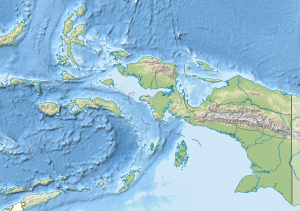Selaru
| Selaru | ||
|---|---|---|
| Mangroves on Selaru in the early 20th century | ||
| Waters | Arafura lake | |
| Archipelago | Tanimbar Islands | |
| Geographical location | 8 ° 11 ′ S , 130 ° 59 ′ E | |
|
|
||
| surface | 775 km² | |
| Residents | 12,249 (2010) 16 inhabitants / km² |
|
Selaru ( Indonesian Pulau Selaru ), formerly South Timor Laut or Seloe , is the second largest of the Indonesian Tanimbar Islands . It is located on the northern edge of the Arafura Sea .
geography
The island forms the southern tip of the Tanimbar Islands. Sealru is separated from the main island of Yamdena by the Egeron Strait . The area of Selarus is 775 km².
Selaru belongs to the administrative district ( Indonesian Kabupaten ) Tanimbar Islands and forms its own district, which is also called Selaru. The administrative district is subordinate to the Indonesian province of Moluccas ( Indonesian Maluku ). The Selaru district also includes the three islands of Anggarmasa (also Angwarmas , with the nature reserve of the same name), Nuyanat and Batbual , located to the west of the Egeron Strait . To the southwest of the coast lies the island of Riama . The islet of Adanar is located in a bay in the south of Selaru .
Selaru is relatively flat and mostly overgrown with grassland. There are numerous coral reefs around the island. The main towns Selarus are on the north coast Adaut , Kandar on the east coast, Namtabung (Namtabun) on the west coast and in the south Linga (Lingat) and Fursui . Other villages are Walsuri , Kore , Vulmana , Falar and Lou in the north , Werain in the center and Abat and Eliase in the south . In the north flows a small river, the Sungai Weria . Cape Arousu forms the southern tip . In the south, between the places Linga and Fursui, lies the highest point on the island, the Gunung Vamith, at 104 m .
Residents and culture
12,249 people live on Serelau (2010 census). Most of them belong to the Selaru ethnic group and the majority are Christians. They are known for their Ikat weaving. The best are said to be in Kandar.
In Adaut, the largest town on the island, and in the other settlements in the northern part of the island, mainly Yamdena live , who otherwise live on the east coast of the island of the same name.
Two large caves near Adaut are so-called cranial caves, in which human skulls and skeletons are scattered, not uncommon in the southwest of the Moluccas. Most of the time, the locals cannot say whose bones are here. The two caves at Adaut have been closed by Christians, but on the other side of Adaut Bay there are others that are untouched.
Unusually for the Moluccas and more common in New Guinea , Selaru cooks in earth ovens.
history
Linga is one of the two oldest villages on the island. During the Second World War there was a Japanese military base here . Their main legacy is an overgrown strip of land. There are also some Japanese bunkers around Linga.
transport
There are daily boats from Adaut to Saumlaki on Yamdena and back.
Web links
Individual evidence
- ↑ The great world atlas. Millennium House, 2009, ISBN 978-1-921209-31-4 .
- ↑ a b c Pulau Selaru . Mapcarta; accessed on November 11, 2016.
- ↑ a b Ethnological map of the Tanimbar Islands , accessed on November 11, 2016.
- ↑ Penduduk Indonesia menurut desa 2010. ( Memento from March 27, 2014 in the Internet Archive ) (PDF; 6.0 MB; Indonesian) accessed on January 26, 2013.
- ^ Tanimbar Islands . ( Memento from November 25, 2015 in the Internet Archive ) Indonesia Traveling; accessed on November 11, 2016.
- ↑ a b c d e f Selaru: The Tanimbars' Second Largest Island . East Indonesia; accessed on November 11, 2016.


